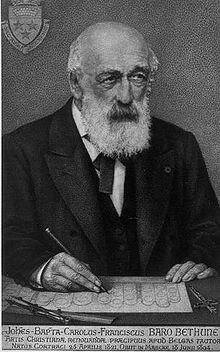Jean-Baptiste Bethune
| Jean-Baptiste Charles François Baron Bethune | |
|---|---|
 |
|
| Born | 25 April 1821 Kortrijk, Belgium |
| Died | 18 June 1894 Marke, Belgium |
| Nationality | Belgian, |
| Occupation | Architect |
| Buildings |
Loppem Castle (in collaboration with E.W. Pugin) |
Loppem Castle (in collaboration with E.W. Pugin)
Jean-Baptiste Bethune was a Belgian architect, artisan and designer who played a pivotal role in the Belgian and Catholic Gothic Revival movement. He was called by some the "Pugin of Belgium", with reference to the leading influence on the Gothic Revival of Augustus Pugin.
He was born in Kortrijk in 1821 in a wealthy Flemish family of French origin. He and his relatives were fervent Catholics, and many were active in politics and civil service. The family which was originally called "Bethune" was in 1845 granted nobility by the Belgian King and added the preposition "de" (some of them took the name "de Béthune-Sully"), in the 20th century, to underline their noble status. However, this great architect never used the particule.
Bethune first studied law at the Catholic University of Leuven and later embarked on a career in public service on the provincial council of West Flanders in Bruges. He received his basic artistic training at the Academy of Fine Arts in Kortrijk (his teachers were L. Verhaegen and Jules Victor Génisson). Paul Lauters introduced him to landscape painting while the sculptor C. H. Geerts (1807–1855) - himself a pioneer of the Gothic Revival style - made him familiar with sculpture. In 1842-1843 and in 1850 he visited England and met Augustus Welby Pugin (1812–1852) the advocate of Gothicism in England and another enthusiastic Catholic.
The encounter with Pugin and his creations further stimulated Bethune's interest in architecture and applied arts. In imitation of Pugin and his followers, Bethune developed the idea that an artistic revival of the arts of the Christian world of the Middle Ages could inspire a new profoundly Christian/Catholic society. At home Bethune was encouraged by Canon C. Carton to become involved in the creation of genuinely "Christian Art". Gradually he began to make designs himself. In 1854 he even set up his own stained-glass workshop, advised by J. Hardman (1812–67), Pugin’s stained-glass manufacturer.
...
Wikipedia
